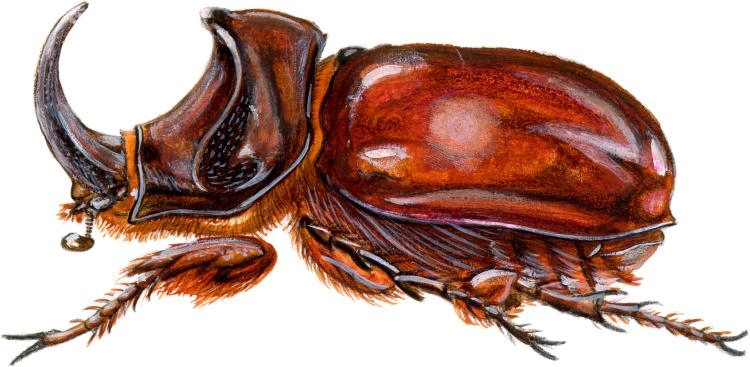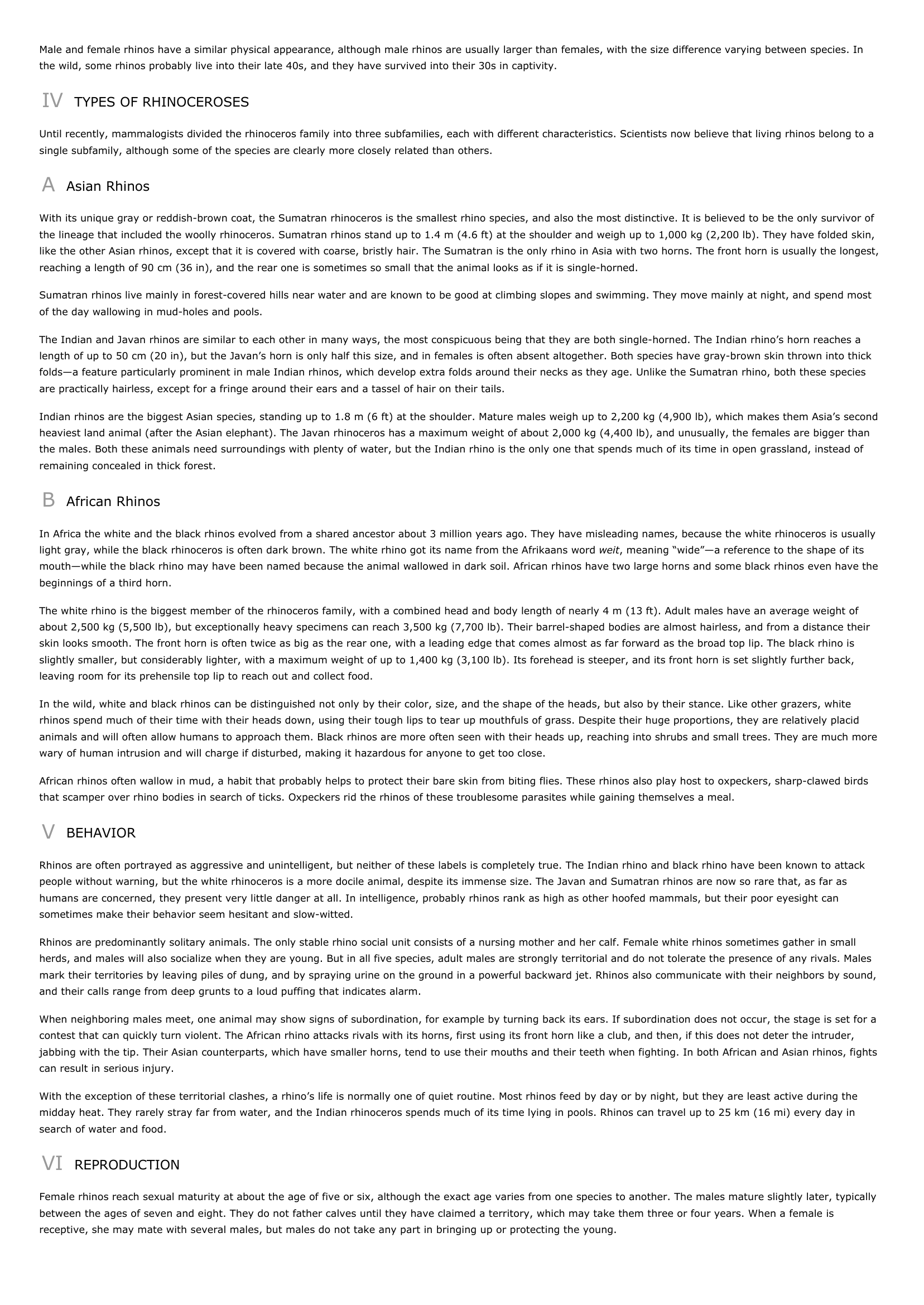Rhinoceros - biology.
Publié le 11/05/2013

Extrait du document


«
Male and female rhinos have a similar physical appearance, although male rhinos are usually larger than females, with the size difference varying between species.
Inthe wild, some rhinos probably live into their late 40s, and they have survived into their 30s in captivity.
IV TYPES OF RHINOCEROSES
Until recently, mammalogists divided the rhinoceros family into three subfamilies, each with different characteristics.
Scientists now believe that living rhinos belong to asingle subfamily, although some of the species are clearly more closely related than others.
A Asian Rhinos
With its unique gray or reddish-brown coat, the Sumatran rhinoceros is the smallest rhino species, and also the most distinctive.
It is believed to be the only survivor ofthe lineage that included the woolly rhinoceros.
Sumatran rhinos stand up to 1.4 m (4.6 ft) at the shoulder and weigh up to 1,000 kg (2,200 lb).
They have folded skin,like the other Asian rhinos, except that it is covered with coarse, bristly hair.
The Sumatran is the only rhino in Asia with two horns.
The front horn is usually the longest,reaching a length of 90 cm (36 in), and the rear one is sometimes so small that the animal looks as if it is single-horned.
Sumatran rhinos live mainly in forest-covered hills near water and are known to be good at climbing slopes and swimming.
They move mainly at night, and spend mostof the day wallowing in mud-holes and pools.
The Indian and Javan rhinos are similar to each other in many ways, the most conspicuous being that they are both single-horned.
The Indian rhino’s horn reaches alength of up to 50 cm (20 in), but the Javan’s horn is only half this size, and in females is often absent altogether.
Both species have gray-brown skin thrown into thickfolds—a feature particularly prominent in male Indian rhinos, which develop extra folds around their necks as they age.
Unlike the Sumatran rhino, both these speciesare practically hairless, except for a fringe around their ears and a tassel of hair on their tails.
Indian rhinos are the biggest Asian species, standing up to 1.8 m (6 ft) at the shoulder.
Mature males weigh up to 2,200 kg (4,900 lb), which makes them Asia’s secondheaviest land animal (after the Asian elephant).
The Javan rhinoceros has a maximum weight of about 2,000 kg (4,400 lb), and unusually, the females are bigger thanthe males.
Both these animals need surroundings with plenty of water, but the Indian rhino is the only one that spends much of its time in open grassland, instead ofremaining concealed in thick forest.
B African Rhinos
In Africa the white and the black rhinos evolved from a shared ancestor about 3 million years ago.
They have misleading names, because the white rhinoceros is usuallylight gray, while the black rhinoceros is often dark brown.
The white rhino got its name from the Afrikaans word weit, meaning “wide”—a reference to the shape of its mouth—while the black rhino may have been named because the animal wallowed in dark soil.
African rhinos have two large horns and some black rhinos even have thebeginnings of a third horn.
The white rhino is the biggest member of the rhinoceros family, with a combined head and body length of nearly 4 m (13 ft).
Adult males have an average weight ofabout 2,500 kg (5,500 lb), but exceptionally heavy specimens can reach 3,500 kg (7,700 lb).
Their barrel-shaped bodies are almost hairless, and from a distance theirskin looks smooth.
The front horn is often twice as big as the rear one, with a leading edge that comes almost as far forward as the broad top lip.
The black rhino isslightly smaller, but considerably lighter, with a maximum weight of up to 1,400 kg (3,100 lb).
Its forehead is steeper, and its front horn is set slightly further back,leaving room for its prehensile top lip to reach out and collect food.
In the wild, white and black rhinos can be distinguished not only by their color, size, and the shape of the heads, but also by their stance.
Like other grazers, whiterhinos spend much of their time with their heads down, using their tough lips to tear up mouthfuls of grass.
Despite their huge proportions, they are relatively placidanimals and will often allow humans to approach them.
Black rhinos are more often seen with their heads up, reaching into shrubs and small trees.
They are much morewary of human intrusion and will charge if disturbed, making it hazardous for anyone to get too close.
African rhinos often wallow in mud, a habit that probably helps to protect their bare skin from biting flies.
These rhinos also play host to oxpeckers, sharp-clawed birdsthat scamper over rhino bodies in search of ticks.
Oxpeckers rid the rhinos of these troublesome parasites while gaining themselves a meal.
V BEHAVIOR
Rhinos are often portrayed as aggressive and unintelligent, but neither of these labels is completely true.
The Indian rhino and black rhino have been known to attackpeople without warning, but the white rhinoceros is a more docile animal, despite its immense size.
The Javan and Sumatran rhinos are now so rare that, as far ashumans are concerned, they present very little danger at all.
In intelligence, probably rhinos rank as high as other hoofed mammals, but their poor eyesight cansometimes make their behavior seem hesitant and slow-witted.
Rhinos are predominantly solitary animals.
The only stable rhino social unit consists of a nursing mother and her calf.
Female white rhinos sometimes gather in smallherds, and males will also socialize when they are young.
But in all five species, adult males are strongly territorial and do not tolerate the presence of any rivals.
Malesmark their territories by leaving piles of dung, and by spraying urine on the ground in a powerful backward jet.
Rhinos also communicate with their neighbors by sound,and their calls range from deep grunts to a loud puffing that indicates alarm.
When neighboring males meet, one animal may show signs of subordination, for example by turning back its ears.
If subordination does not occur, the stage is set for acontest that can quickly turn violent.
The African rhino attacks rivals with its horns, first using its front horn like a club, and then, if this does not deter the intruder,jabbing with the tip.
Their Asian counterparts, which have smaller horns, tend to use their mouths and their teeth when fighting.
In both African and Asian rhinos, fightscan result in serious injury.
With the exception of these territorial clashes, a rhino’s life is normally one of quiet routine.
Most rhinos feed by day or by night, but they are least active during themidday heat.
They rarely stray far from water, and the Indian rhinoceros spends much of its time lying in pools.
Rhinos can travel up to 25 km (16 mi) every day insearch of water and food.
VI REPRODUCTION
Female rhinos reach sexual maturity at about the age of five or six, although the exact age varies from one species to another.
The males mature slightly later, typicallybetween the ages of seven and eight.
They do not father calves until they have claimed a territory, which may take them three or four years.
When a female isreceptive, she may mate with several males, but males do not take any part in bringing up or protecting the young..
»
↓↓↓ APERÇU DU DOCUMENT ↓↓↓
Liens utiles
- FICHE DE LECTURE : RHINOCEROS d'Ionesco
- Rhinoceros complémentaire
- RHINOCEROS ACTE I SCENE I
- Rhinoceros Ionesco
- mise en scene de Marcymota rhinoceros


